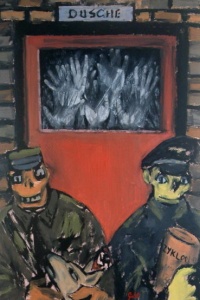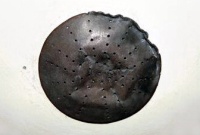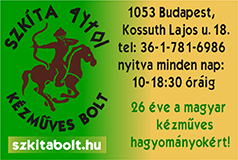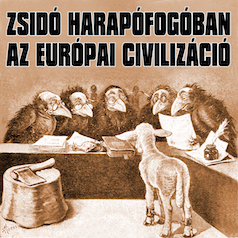Sürgős felhívás!
 |
- Tömegsírok léteztek, amelyekből csatornákon át vezették el a vért, sőt, az emberi zsírt. [1]
- Savba vagy forró vízbe tették az elítélteket, és így gyilkolták meg őket. [2]
- Injekciót fecskendeztek a szemükbe, hogy megváltoztassák a színét. [3]
- A koncentrációs táborok foglyainak fejét összezsugorították. [4]
- A krematóriumokban elégetett testek zsírját felfogták különleges edényekben. [5]
- Egy SS-katona megsajnált egy gázkamrába bezárt anyukát és gyerekét, ezért az utolsó pillanatban beugrott melléjük, és velük együtt halt meg. [6]
- A megölt zsidók testéből szappant főztek. Volt rá példa, hogy szappanokat a zsidók el is temettek, mintha emberek lettek volna. [7]
- Elektromos árammal gyilkolták le a zsidók tömegeit hatalmas földalatti helyiségekben. [8]
- Zsidók tömegeit ölték meg úgy, hogy bezárták őket egy terembe, ahonnan kiszivattyúzták a levegőt, másokat pedig diesel-motorokból kiáramló gőz segítségével gyilkoltak meg, de a klórgázt is használták ölésre a nácik. [9]
- A hatalmas tömegsírokból néhány hét alatt minden nyom nélkül eltávolítottak több százezer holttestet. [10]
- Treblinkában kerekeken guruló gázkamrák voltak, amelyek a holttesteket egészen a hatalmas égetőkemencékig hurcolták, ahova a halottakat belezúdították. De volt olyan is, hogy késleltetve adagolták a mérges gázt, így aztán egyesek a saját lábukon mentek az égető kemencékig. [11]
- Elektromos futószalagon történt a foglyok legyilkolása.[12]
- Hatalmas kemencékben, illetve hatalmas "rostélyokon" élve égették el az áldozataikat a nácik. [13]
- SS-katonák bicikliversenyt rendeztek az auschwitzi gázkamrákhoz. [14]
- A holttesteket úgy tüntették el, hogy felrobbantották őket. [15]
- Kék pára lebegett az elgázosítottak tetemei felett a gázkamrában /A hidrocianid egyébként színtelen gáz./ [16]
- A gázkamrákba bezárt emberek énekelték a nemzeti himnuszaikat, illetve az Internacionálét a haláluk előtti percekben. [17]
- A nácik hordozható, könnyen áttelepíthető gázkamrákat is építettek. [18]
- Folyékony hidrocianidot is itattak az áldozataikkal. [19]
- A kivégzés után kivágták az elítéltek lábaiból az izmokat orvosi kísérlet céljára. [20]
 |
- Az SS-katonák kolbászt készítettek a megölt emberek húsából. [22]
- Ilse Koch, a buchenwaldi táborparancsnok felesége megölt zsidók mumifikálódott hüvelykujját használta villanykapcsolónak a lakásában. [23]
- Flossburgban a kémlelőlyukon át kaptak levegőt az elítéltek, s amikor az ajtó kinyílt, elátkozták az SS-katonákat, és mindenkinek sikerült elmenekülnie. [24]
Íme a fenti állítások forrásai:
[1] A. Rückerl, op. cit. (note 141), p. 273f.; E. Wiesel, Paroles d'Etranger, Editiondu Seuil, Paris 1982, p. 86; A. Eichmann, in: H. Arendt, op. cit. (note 179), p.184; B. Naumann, op. cit. (note 142), p. 214.
[2] F. Müller, in: H. Langbein, op. cit. (note 151), v. 1, p. 87; witness Wells in the Eichmann Trial, in: F. J. Scheidl, op. cit. (note 74), v. 4, p. 236.
[3] H. Langbein, Menschen in Auschwitz, op. cit. (note 152), pp. 383f.
[4] H. Langbein, ibid., p. 381.
[5] R. Höß, in: M. Broszat (ed.), op. cit. (note 71), p. 130; H. Tauber, in: J.-C. Pressac, op. cit. (note 17), pp. 489f.; F. Müller, Sonderbehandlung, Steinhausen,Munich 1979, pp. 207f., 217ff.; H. Langbein, Menschen in Auschwitz, op. cit.(note 152), p. 148; B. Naumann, op. cit. (note 142), pp. 10, 334f., 443; S. Steinberg, according to: Französisches Büro des Informationsdienstes überKriegsverbrechen (ed.), Konzentrationslager Dokument 321, Reprint 2001, Frankfurt/Main 1993, p. 206; and many more.
[6] E. Bonhoeffer, op. cit. (note 213), pp. 48f.
[7] S. Wiesenthal, Der neue Weg (Vienna), 15/16 & 17/18, 1946; the Soviets wanted to make this one of the charges at the IMT (exhibit USSR-393), but this plan failed due to the other Allies; cf. H. Härtle, Freispruch für Deutschland, Schütz, Göttingen 1965, pp. 126ff.; the Greenwood Cemetery in Atlanta (Georgia, USA) is not the only site to boast a Holocaust-memorial gravestone for 4 bars of "Jewish soap". Cf. also the following corrections: R. Harwood, D. Felderer, JHR 1(2) (1980) pp. 131-139; M. Weber, JHR 11(2) (1991) pp. 217-227.
[8] Aside from C. Mattogno, op. cit. (note 339), cf. esp. S. Szende, Der letzte Jude aus Polen, Europa-Verlag, Zürich 1945; S. Wiesenthal, Der neue Weg (Vienna), 19/20, 1946.
[9] Aside from C. Mattogno, op. cit. (note 339), cf. esp. W. Grossmann, Die Hölle von Treblinka, Verlag für fremdsprachige Literatur, Moscow 1947; The Black Book of Polish Jewry, Roy Publishers, New York 1943.
[10] Aside from note 349, cf. also W. Benz, Dimension des Völkermords, Oldenbourg, Munich 1991; pp. 320, 469, 479, 489, 537ff.
[11] Reports of the Polish underground movement, Archiv der Polnischen Vereinigten Arbeiterpartei, 202/III, v. 7, pp. 120f., quoted in: P. Longerich, op. cit.(note 271), p. 438.
[12] Pravda, Feb. 2, 1945, cf. U. Walendy, Historische Tatsachen No. 31: "Die Befreiung von Auschwitz 1945", Verlag für Volkstum und Zeitgeschichtsforschung, Vlotho 1987, p. 4.
[13] H. von Moltke, Briefe an Freya 1939-1945, Beck, Munich 1988, p. 420; cf. P. Longerich (ed.), op. cit. (note 271), p. 435; Pravda, Feb. 2, 1945.
[14] Nürnberger Nachrichten, Sept. 11, 1978, report about eyewitness testimony in the jury court trial in Aschaffenburg.
[15] R. Höß, in: M. Broszat (ed.), op. cit. (note 71), pp. 161f.; A. Rückerl, NS-Prozesse, op. cit. (note 127), p. 78; H. Grabitz, NS-Prozesse., op. cit. (note191), p. 28.
[16] R. Böck, Frankfurt Public Prosecutor's Office, Ref. 4 Js 444/59, pp. 6881f.
[17] H. G. Adler, H. Langbein, E. Lingens-Reiner (eds.), Auschwitz - Zeugnisse und Berichte, Europäische Verlagsanstalt, Cologne 1984, p. 76.
[18] R. Aschenauer (ed.), Ich, Adolf Eichmann, Druffel, Leoni 1980, pp. 179f.
[19] Verdict of the Hannover District Court, Ref. 2 Ks 1/60; cf. H. Lichtenstein, op. cit. (note 84), p. 83.
[20] F. Müller, op. cit. (note 345), p. 74.
[21] M. Scheckter and a report of June 4, 1945, written by an officer of the 2nd Armored Division, about Auschwitz; Französisches Büro des Informationsdienstes über Kriegsverbrechen (ed.), op. cit. (note 345), p. 184.
[22] David Pressac, in J.-C. Pressac, op. cit. (note 17), p. 554, fourth column, lines 17-22.
[23] Kurt Glass, New York Times, April 10. 1995.
from: 'Death Was Our Destiny', p.49-50, by Arnold Friedman,
Vantage Press, 1972.
[24] Arnold Friedman, Death Was Our Destiny, Vantage Press, 1972, p.49-50
[2] F. Müller, in: H. Langbein, op. cit. (note 151), v. 1, p. 87; witness Wells in the Eichmann Trial, in: F. J. Scheidl, op. cit. (note 74), v. 4, p. 236.
[3] H. Langbein, Menschen in Auschwitz, op. cit. (note 152), pp. 383f.
[4] H. Langbein, ibid., p. 381.
[5] R. Höß, in: M. Broszat (ed.), op. cit. (note 71), p. 130; H. Tauber, in: J.-C. Pressac, op. cit. (note 17), pp. 489f.; F. Müller, Sonderbehandlung, Steinhausen,Munich 1979, pp. 207f., 217ff.; H. Langbein, Menschen in Auschwitz, op. cit.(note 152), p. 148; B. Naumann, op. cit. (note 142), pp. 10, 334f., 443; S. Steinberg, according to: Französisches Büro des Informationsdienstes überKriegsverbrechen (ed.), Konzentrationslager Dokument 321, Reprint 2001, Frankfurt/Main 1993, p. 206; and many more.
[6] E. Bonhoeffer, op. cit. (note 213), pp. 48f.
[7] S. Wiesenthal, Der neue Weg (Vienna), 15/16 & 17/18, 1946; the Soviets wanted to make this one of the charges at the IMT (exhibit USSR-393), but this plan failed due to the other Allies; cf. H. Härtle, Freispruch für Deutschland, Schütz, Göttingen 1965, pp. 126ff.; the Greenwood Cemetery in Atlanta (Georgia, USA) is not the only site to boast a Holocaust-memorial gravestone for 4 bars of "Jewish soap". Cf. also the following corrections: R. Harwood, D. Felderer, JHR 1(2) (1980) pp. 131-139; M. Weber, JHR 11(2) (1991) pp. 217-227.
[8] Aside from C. Mattogno, op. cit. (note 339), cf. esp. S. Szende, Der letzte Jude aus Polen, Europa-Verlag, Zürich 1945; S. Wiesenthal, Der neue Weg (Vienna), 19/20, 1946.
[9] Aside from C. Mattogno, op. cit. (note 339), cf. esp. W. Grossmann, Die Hölle von Treblinka, Verlag für fremdsprachige Literatur, Moscow 1947; The Black Book of Polish Jewry, Roy Publishers, New York 1943.
[10] Aside from note 349, cf. also W. Benz, Dimension des Völkermords, Oldenbourg, Munich 1991; pp. 320, 469, 479, 489, 537ff.
[11] Reports of the Polish underground movement, Archiv der Polnischen Vereinigten Arbeiterpartei, 202/III, v. 7, pp. 120f., quoted in: P. Longerich, op. cit.(note 271), p. 438.
[12] Pravda, Feb. 2, 1945, cf. U. Walendy, Historische Tatsachen No. 31: "Die Befreiung von Auschwitz 1945", Verlag für Volkstum und Zeitgeschichtsforschung, Vlotho 1987, p. 4.
[13] H. von Moltke, Briefe an Freya 1939-1945, Beck, Munich 1988, p. 420; cf. P. Longerich (ed.), op. cit. (note 271), p. 435; Pravda, Feb. 2, 1945.
[14] Nürnberger Nachrichten, Sept. 11, 1978, report about eyewitness testimony in the jury court trial in Aschaffenburg.
[15] R. Höß, in: M. Broszat (ed.), op. cit. (note 71), pp. 161f.; A. Rückerl, NS-Prozesse, op. cit. (note 127), p. 78; H. Grabitz, NS-Prozesse., op. cit. (note191), p. 28.
[16] R. Böck, Frankfurt Public Prosecutor's Office, Ref. 4 Js 444/59, pp. 6881f.
[17] H. G. Adler, H. Langbein, E. Lingens-Reiner (eds.), Auschwitz - Zeugnisse und Berichte, Europäische Verlagsanstalt, Cologne 1984, p. 76.
[18] R. Aschenauer (ed.), Ich, Adolf Eichmann, Druffel, Leoni 1980, pp. 179f.
[19] Verdict of the Hannover District Court, Ref. 2 Ks 1/60; cf. H. Lichtenstein, op. cit. (note 84), p. 83.
[20] F. Müller, op. cit. (note 345), p. 74.
[21] M. Scheckter and a report of June 4, 1945, written by an officer of the 2nd Armored Division, about Auschwitz; Französisches Büro des Informationsdienstes über Kriegsverbrechen (ed.), op. cit. (note 345), p. 184.
[22] David Pressac, in J.-C. Pressac, op. cit. (note 17), p. 554, fourth column, lines 17-22.
[23] Kurt Glass, New York Times, April 10. 1995.
from: 'Death Was Our Destiny', p.49-50, by Arnold Friedman,
Vantage Press, 1972.
[24] Arnold Friedman, Death Was Our Destiny, Vantage Press, 1972, p.49-50
Perge Ottó







